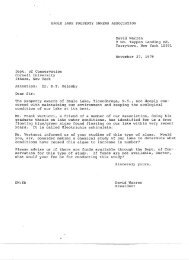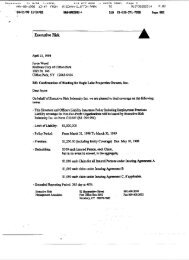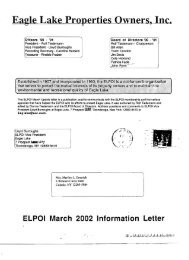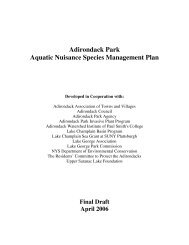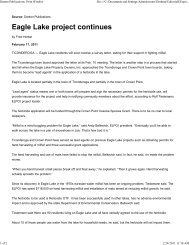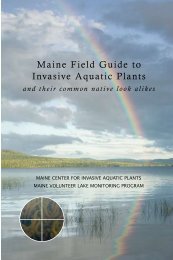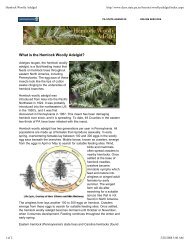SEIS - Eagle Lake Property Owner's Inc.
SEIS - Eagle Lake Property Owner's Inc.
SEIS - Eagle Lake Property Owner's Inc.
Create successful ePaper yourself
Turn your PDF publications into a flip-book with our unique Google optimized e-Paper software.
Successful use is related to selection of materials and the quality of the application. As a resultof field experience with benthic barriers in many lakes, including <strong>Lake</strong> George, severalguidelines can be offered:+ Porous barriers will be subject to less billowing, but will allow settling plant fragments toroot and grow; annual maintenance is therefore essential+ Solid barriers will generally prevent rooting in the absence of sediment accumulations, butwill billow after enough gases accumulate; venting and strong anchoring are essential in mostcases+ Plants under the barrier will usually die completely after about a month, with solid barriersmore effective than porous ones in killing the whole plant; barriers of sufficient tensilestrength can then be moved to a new location, although continued presence of solid barriersrestricts recolonization.Proper application requires that the screens be placed flush with the sediment surface and stakedor securely anchored. This may be difficult to accomplish over dense plant growth, and a winterdrawdown can provide an ideal opportunity for application. Late spring application has also beeneffective, however, despite the presence of plant growths at that time, and barriers applied inearly May have been removed in mid-June with no substantial plant growth through the summer(Wagner, 1991). Scuba divers normally apply the covers in deeper water, which greatlyincreases labor costs. Bottom barriers will accumulate sediment deposits in most cases, whichallows plant fragments to root. Barriers must then be cleaned, necessitating either removal orlaborious in-place maintenance.Recolonization of plants following benthic barrier application and removal in tW0 swimmingareas in Great Pond, Massachusetts, has also been studied (Wagner, 1991). These applicationswere for the purpose of improving swimming safety, and did not involve control of any invasivenon-native species. In one swimming area, a plant community not differentiable from theoriginal assemblage was restored mainly from seed germination within one to two years afterbarrier removal. Only one new species was detected, a native plant found in neighboring ponds,and then only as a very minor component of the post-treatment plant community. In the otherswimming area, foot traffic in sections which were considered unusable prior to treatmentresulted in continued minimal plant growth.The ability of milfoil fragments to recolonize porous (mesh) benthic barriers has made porousbarriers less useful for combating infestations by milfoil on any but the smallest scale, as sheetsmust be removed and cleaned at least yearly. Solid barriers have been more useful, although gasentrapment has been troublesome; billowing occurs without venting and anchoring, yetappropriate venting and anchoring creates problems for eventual maintenance or redeployment.Expense dictates that only limited areas be treated without re-use of deployed barrier.Nevertheless, benthic barriers are capable of providing control of milfoil on at least a localizedbasis (Engel, 1984; Perkins et aI., 1980;, Helsel et aI., 1996), and have such desirable sidebenefits as creating more edge habitat within dense plant assemblages and minimizing turbiditygeneration from fine bottom sediments.D<strong>SEIS</strong> for <strong>Eagle</strong> <strong>Lake</strong> 32 ENSR



